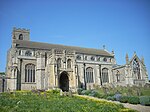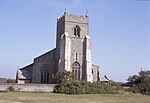Glandford (Hurdle Lane)
Geological Conservation Review sitesSites of Special Scientific Interest in Norfolk

Glandford (Hurdle Lane) is a 9.4-hectare (23-acre) geological Site of Special Scientific Interest west of Sheringham in Norfolk. It is a Geological Conservation Review site and it is in the Norfolk Coast Area of Outstanding Natural Beauty.This is a working quarry in the valley of the River Glaven. It has a complex sequence of deposits formed by Pleistocene glaciers, with till, lacustrine calcareous silts, sands and coarse gravels, which throw light on the glacial history of the area.The site is private land with no public access.
Excerpt from the Wikipedia article Glandford (Hurdle Lane) (License: CC BY-SA 3.0, Authors, Images).Glandford (Hurdle Lane)
Hurdle Lane, North Norfolk Cley Next The Sea
Geographical coordinates (GPS) Address Nearby Places Show on map
Geographical coordinates (GPS)
| Latitude | Longitude |
|---|---|
| N 52.932 ° | E 1.053 ° |
Address
Hurdle Lane
Hurdle Lane
NR25 7JR North Norfolk, Cley Next The Sea
England, United Kingdom
Open on Google Maps










